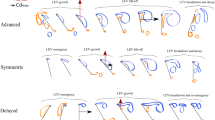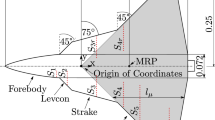Abstract
High-resolution Particle-Image Velocimetry (PIV) and time-resolved force measurements were performed to analyze the impact of the comb-like structure on the leading edge of barn owl wings on the flow field and overall aerodynamic performance. The Reynolds number was varied in the range of 40,000 to 120,000 and the range of angle of attack was 0° to 6° for the PIV and −15° to +20° for the force measurements to cover the full flight envelope of the owl. As a reference, a wind-tunnel model which possessed a geometry based on the shape of a typical barn owl wing without any owl-specific adaptations was built, and measurements were performed in the aforementioned Reynolds number and angle of attack range. This clean wing model shows a separation bubble in the distal part of the wing at higher angles of attack. Two types of comb-like structures, i.e., artificial serrations, were manufactured to model the owl’s leading edge with respect to its length, thickness, and material properties. The artificial structures were able to reduce the size of the separation region and additionally cause a more uniform size of the vortical structures shed by the separation bubble within the Reynolds number range investigated, resulting in stable gliding flight independent of the flight velocity. However, due to increased drag coefficients in conjunction with similar lift coefficients, the overall aerodynamic performance, i.e., lift-to-drag ratio is reduced for the serrated models. Nevertheless, especially at lower Reynolds numbers the stabilizing effect of the uniform vortex size outperforms the lower aerodynamic performance.
Similar content being viewed by others
References
Lilley G M A. Study of the silent flight of the owl. The 4th AIAA/CEAS Aeroacoustics Conference, Toulouse, France, 1998, AIAA Paper 98-2340.
Mebs T, Scherzinger W. Die Eulen Europas, Franck-Kosmos Verlag, Stuttgart, Germany, 2000. (in German)
McMasters J H, Henderson M L. Low speed single element airfoil synthesis. Technical Soaring, 1980, 6, 1–21.
Klän S, Bachmann T, Klaas M, Wagner H, Schröder W. Experimental analysis of the flow field over a novel owl based airfoil. Experiments in Fluids, 2008, 46, 975–989.
Graham R R. The silent flight of owls. Journal of the Royal Aeronautical Society, 1934, 38, 837–843.
Bachmann T. Anatomical, Morphometrical, and Biomechanical Studies of Barn Owls’ and Pigeons’ Wings, PhD Thesis, RWTH Aachen University, Germany, 2010.
Bachmann Wagner H. The three-dimensional shape of serrations at barn owl wings: Towards a typical natural serration as a role model for biomimetic applications. Journal of Anatomy, 2011, 219, 192–202.
Bachmann T, Winzen A. Owl inspired silent flight. In: Jabbari E, Kim D H, Lee L P, Ghaemmaghami A, Khademhosseini A (eds). Handbook of Biomimetics and Bioinspiration Biologically, World Scientific Publishing Company, Sigapore, 2014.
Schwind R G, Allen H J. The effect of leading-edge serrations on reducing flow unsteadiness about airfoils. AIAA 11th Aerospace Sciences Meeting, Washington, DC, USA, 1973.
Collins F. Boundary layer control on wings using sound and leading-edge serrations. Aircraft Systems and Technology Meetings, Tennessee, University, Tullahoma, Tenn, USA, 1979.
Hersh A S, Soderman P T, Hayden R E. Investigation of acoustic effects of leading-edge serrations on airfoils. Journal of Aircraft, 1974, 11, 197–202.
Arndt R E A, Nagel R T. Effect of leading-edge serrrations on noise radiation from a model rotor. The AIAA 5th Fluid and Plasma Dynamics Conference, Boston, Massachusetts, USA, 1972, AIAA Paper 1972-655.
Soderman P T. Leading-edge serrations which reduce the noise of low-speed rotors. NASA Technical Report, TN D-7371, 1973.
Soderman P T. Aerodynamic effect of leading-edge serrations on a two-dimensional airfoil. NASA Technical Report, TM X-2643, 1972.
Kerho M F, Hutcherson S, Blackwelder R F, Liebeck R H. Vortex generators used to control laminar separation bubbles. Journal of Aircraft, 1993, 30, 315–319.
Ito S. Aerodynamic influence of leading-edge serrations on an airfoil in a low Reynolds number: A study of an owl wing with leading-edge serrations. Journal of Biomechanical Science and Engineering, 2009, 4, 117–123.
Klän S, Klaas M, Schröder W. The influence of leading-edge serrations on the flow field of an artificial owl wing. The 28th AIAA Applied Aerodynamics Conference, Chicago, USA, 2010, AIAA Paper 2010–4942.
Mueller T J. The influnce of laminar separation and transition on low Reynolds number airfoil hysteresis. Journal of Aircraft, 1985, 22, 763–770.
Mueller T J, Pohlen L J, Conigliaro P E, Jansen J B J. The influence of free-stream disturbances on low Reynolds number airfoil experiments. Experiments in Fluids, 1983, 1, 3–14.
Burgmann S, Schröder W. Investigation of the vortex induced unsteadiness of a separation bubble via time-resolved and scanning PIV measurements. Experiments in Fluids, 2008, 45, 675–691.
Zierke W C, Deutsch S. An analysis to facilitate the interpretation of boundary layer measurements. NASA Technical Report, TM-8585, 1985.
Winzen A, Klaas M, Schröder W. High-speed particle image velocimetry and force measurements of bio-inspired surfaces. Journal of Aircraft, 2014. doi: 10.2514/1.C032742
Anderson J D Jr. Fundamentals of Aerodynamics, McGraw-Hill Higher Education, New York, USA, 2001.
Walz A. Boundary Layers of Flows and Temperature, MIT Press, Cambridge, USA, 1969.
Schlichting H. Boundary Layer Theory, McGraw-Hill, New York, USA, 1979.
Ludweig H, Tillman W. Untersuchungen über die wandschubspannung in turbulenten reibungsschichten. Ingenieur Archiv, 1949, 17, 288–299. (in German)
Squire H, Young A. The calculation of the profile drag of aerofoils. R&M Technical Report, No.1838, British ARC, 1938.
Author information
Authors and Affiliations
Corresponding author
Rights and permissions
About this article
Cite this article
Winzen, A., Roidl, B., Klän, S. et al. Particle-image velocimetry and force measurements of leading-edge serrations on owl-based wing models. J Bionic Eng 11, 423–438 (2014). https://doi.org/10.1016/S1672-6529(14)60055-X
Published:
Issue Date:
DOI: https://doi.org/10.1016/S1672-6529(14)60055-X




